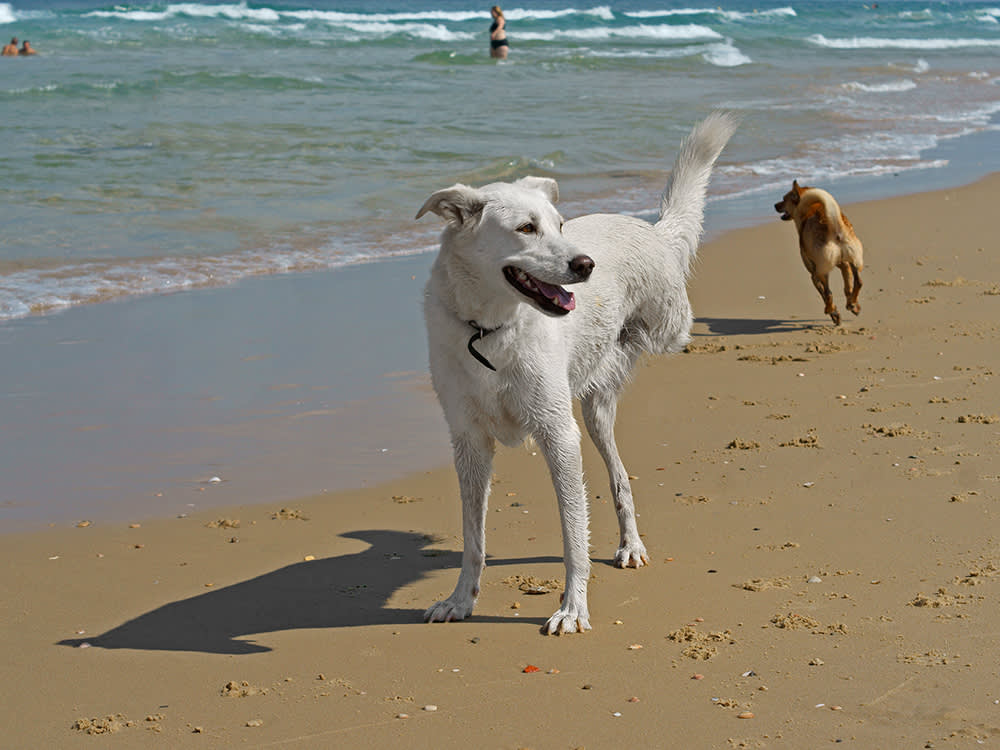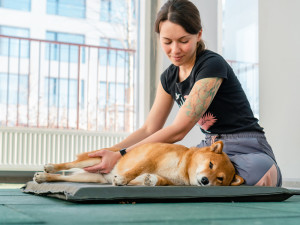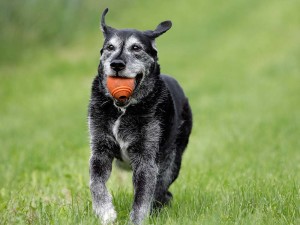How to Keep Your Three-Legged Dog Outpacing All the Other Pups at the Park
Six tips to help your tripod dog stay in tip-top shape

share article
If you’ve taken a three-legged pup to the park, you’ll know they can race around just as fast – if not faster – than the four-legged friends they meet there. Still, while your speedy little tripod is definitely a champ, they may have taken some time to adjust to life without that fourth limb.
Some three-legged dogs do better than others, depending on their size (smaller dogs have it easier), age, and other physical problems. “The biggest challenge a dog faces when they lose a limb is that they have to relearn proprioception, which means they need to get a new idea of where their body is in space and how to balance,” says Sheila Wells, a hydrotherapist in Seattle.
Losing a front leg also poses a greater challenge than losing a back one. “The front leg accounts for approximately 70 percent of the dog’s strength and balance,” says Wells. “So front-leg amputees often have a more difficult time adjusting to their new state. The rear can follow, but the front has to lead.”
Even if a three-legged dog lost their limb because of trauma or disease, most often they will bounce back and adjust. As Wells points out, dogs don’t have to face the same stigma that humans do around losing a limb.
“Some don’t ever notice their leg is missing,” she says. “Usually a leg that has been taken off has been painful for a long time and the dog is already used to not using that leg. When they get it removed, their whole demeanour changes because they can run around without being in pain. There’s no reason a three-legged dog has to be disabled.”
Here are six ways to keep your three-legged dog happy and healthy.
Keep an eye on their remaining legs
The most important challenge for tripod dog owners, Wells says, is to protect the remaining limbs. Often people will let the dog overdo it, and that ends up putting undue stress on the dog’s joints, which can lead to injuries and arthritis. Help them out by putting a sock or pad on the ‘elbow’ of the remaining legs to prevent calluses and pressure sores. Keeping your dog on a healthy diet and helping them maintain a lower weight also helps; that way, there’s less pressure on their joints.
Make sure they’re moving
Staying active is key for a three-legged dog. That can include any exercise your dog loves – from games of fetch at the park to regular walks around the block. But hitting the pool or another safe body of water is best because the water takes the stress off their body. See if there’s a place in your area that offers swim therapy.
Don’t let them overdo it
Monitor your three-legged dog’s activity level and don’t let them go overboard. You’ll want to keep a close eye on your tripod dog going up and down stairs or moving on other uneven surfaces, especially when they’re just starting out post-amputation and getting used to their new normal.
Ease those achy joints
After an accident left Mastiff / Husky mix Harvey with a badly broken right rear leg, his owners knew amputation was the best choice. They try to keep Harvey from overexercising so that he doesn’t injure his remaining limbs, and they give him glucosamine for his joints. This, along with fish oils and other anti-inflammatory supplements, can do a lot for easing pressure on your dog’s remaining limbs.
Get in gear
You may need to invest in a wheelchair, if necessary, to help with mobility, or look into prosthetics. There are options if a dog is missing a foot or two – or maybe three or four – and new advancements in prosthetics are made all the time. Martin Kaufmann, of OrthoPetsopens in a new tab, makes prosthetics and orthotics for both “two-legged and four-legged animals and any variation in the middle”.
His goal is “to get the animal world up to speed with what we’re doing with humans”. He began his practice with animals four years ago, after a cousin’s Schnauzer suffered a stroke and lost use of their right front leg. Kaufmann began studying animal anatomy books and learnt that the muscle and bone terminology in dogs is almost exactly what it is in humans. Now, 30 percent of his practice is making artificial limbs and braces for animals, mostly dogs. For front-leg amputations, you’ll also want to use a car seat harness with wide chest bands.
Call in the experts
Along with talking with your regular vet, you’ll probably also want to connect with other providers who can help your three-legged dog with everything from assistive equipment to physical therapy. Check out these online providers to help keep your dog at their best.
Wheels4Dogsopens in a new tab
Wheels4Dogs specialise in disability aids for pets, which means their online store is filled not just with wheelchairs, but also harnesses, boots and socks, and leg support devices. Based in Worcestershire, they’re also the official UK importer of the popular Walkin’ Wheels wheelchair range.
Zoomadogopens in a new tab
London-based Zoomadog have been selling rehabilitation and medical products for dogs since 2011. Their online store includes a wide range of dog wheelchairs tailored to various breeds, as well as leg supports and splints, boots and socks, and back, knee and hip braces. They also stock various joint-improving and pain-relieving supplements.
NAVP
The National Association of Veterinary Physiotherapists (NAVP) was formed in 1985 to promote and advance the practise of pet physiotherapy. All of its members are qualified via a recognised accredited training programme, have the necessary professional insurance and work according to a standardised code of conduct. You can use the website’s ‘find a member’ tool to locate a qualified dog physiotherapist near you.
Dana Standish
Dana Standish lives in Seattle.




